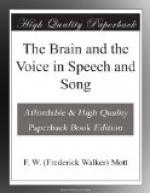3. Resonants.—In the production of the consonant m, and sometimes n, the nasal resonator comes into play because the soft palate is not raised at all and the sound waves produced in the larynx find a free passage through the nose, while the mouth portion of the resonator is completely closed by the lips. The sounds thus produced are very telling in the singing voice.
4. Vibratory Sounds.—There are three situations in which the consonant r may be formed, but in the English language it is produced by the vibration of the tip of the tongue in the constricted portion of the cavity of the mouth, formed by the tongue and the teeth.
The consonants have been grouped by Hermann as follows:—
| |Labials.|Dentals. |Gutturals.| |1. Explosives-- | | | | |a. Without the voice|P |T |K | |b. With the voice |B |D |G | |2. Aspirates-- | | | | |a. Without the voice|F |S (hard), L, Sh,|Ch | | | |Th (hard) | | |b. With the voice |V |Z, L, Th, Zh |Y in yes | | | |(soft) | | |3. Resonants |M |N |N (nasal) | |4. Vibratory sounds|Labial R|Lingual R |Guttural R|
H is the sound produced in the larynx by the quick rushing of the air through the widely opened glottis.
Hermann’s classification which I have given is especially valuable as regards the speaking voice, but Aikin classifies the consonants from the singing point of view, according to the more or less complete closure of the resonator.
CLASSIFICATION OF CONSONANTS (AIKIN)
Jaw fully open H, L, K, G " less " T, D, N, R " nearly closed, lips closed P, B, M " " " upper lip on lower teeth F, V " quite closed S, Z, J, N, Ch, Sh
Aikin, moreover, points out that the English language is so full of closures that it is difficult to keep the resonator open, and that accounts for one of the principal difficulties in singing it.
“The converse of this may be said of Italian, in which most words end in pure vowels which keep the resonator open. In fact, it is this circumstance which has made the Italian language the basis of every point of voice culture and the producer of so many wonderful singers.” As an example compare the English word ‘voice,’ which begins with closure and ends with closure, and the Italian ‘voce,’ pronounced voche, with its two open vowel sounds. The vowel sound ah on the note c is the middle tone of the speaking register, and as we know, can be used all day long without fatigue; therefore in training the voice the endeavour should




